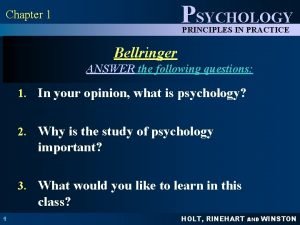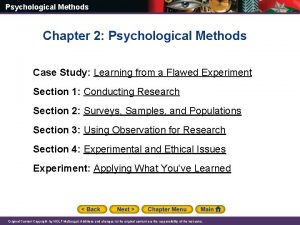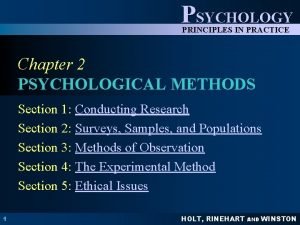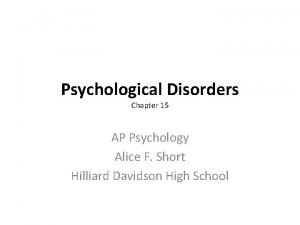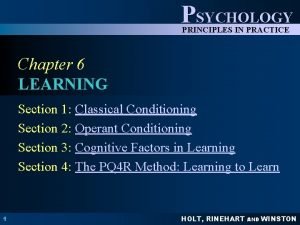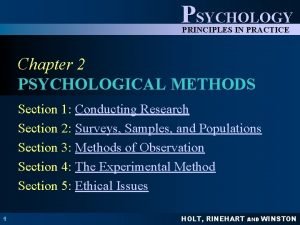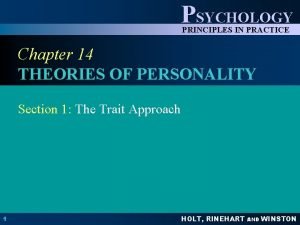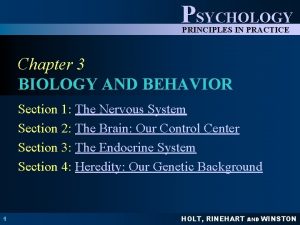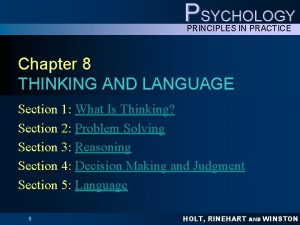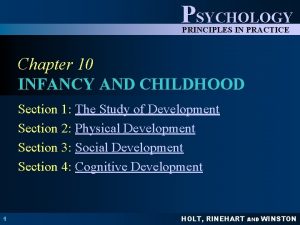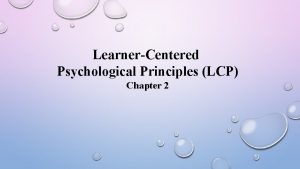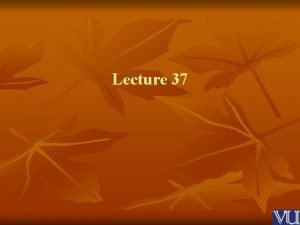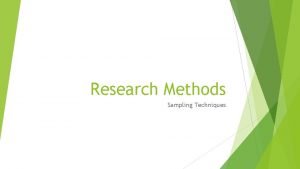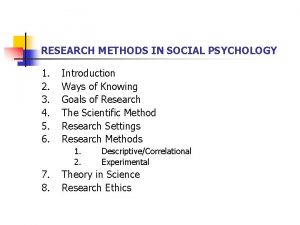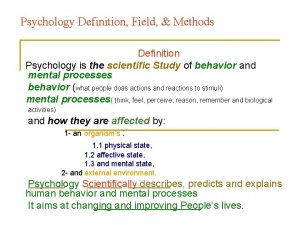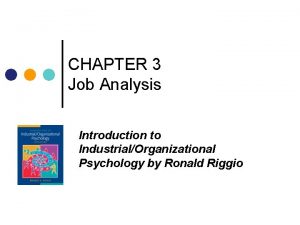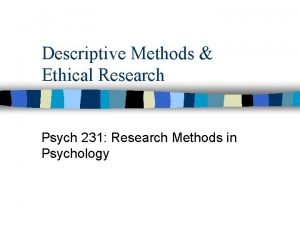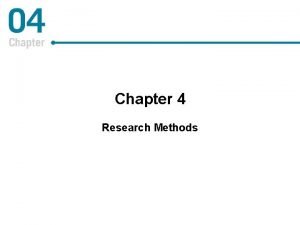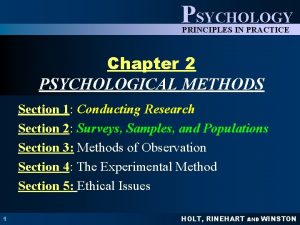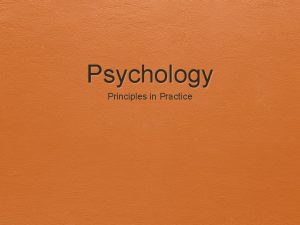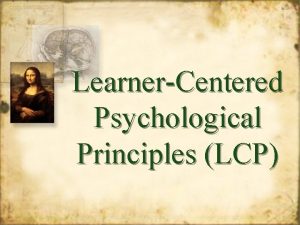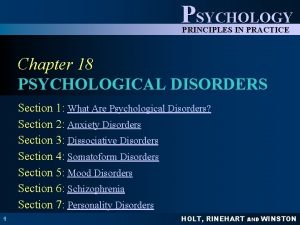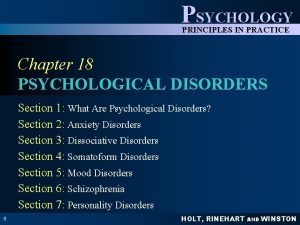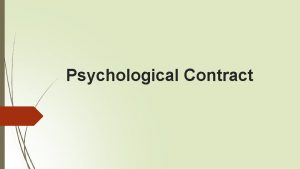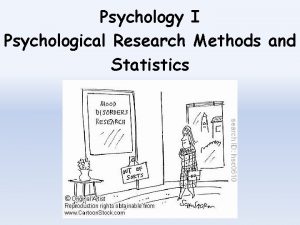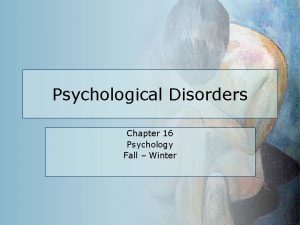PSYCHOLOGY PRINCIPLES IN PRACTICE Chapter 2 PSYCHOLOGICAL METHODS





















- Slides: 21

PSYCHOLOGY PRINCIPLES IN PRACTICE Chapter 2 PSYCHOLOGICAL METHODS Section 1: Conducting Research Section 2: Surveys, Samples, and Populations Section 3: Methods of Observation Section 4: The Experimental Method Section 5: Ethical Issues 1 HOLT, RINEHART AND WINSTON

Chapter 2 Section 1: Conducting Research PSYCHOLOGY PRINCIPLES IN PRACTICE Question: What steps do scientists follow in conducting scientific research? STEPS IN SCIENTIFIC RESEARCH n Form a question (posing a question based on experience, psychological theory or common knowledge) 2 HOLT, RINEHART AND WINSTON

Chapter 2 PSYCHOLOGY PRINCIPLES IN PRACTICE n Form a hypothesis (making an educated guess) n Conceptualizing a problem. This step involves taking an issue that the researcher is curious or skeptical about and expressing it in terms of operational definitions and hypotheses. 3 HOLT, RINEHART AND WINSTON

Chapter 2 PSYCHOLOGY PRINCIPLES IN PRACTICE n How would you operationally define love? 4 HOLT, RINEHART AND WINSTON

Chapter 2 PSYCHOLOGY PRINCIPLES IN PRACTICE n Test the hypothesis (examining the evidence through any of a variety of means) n Based on the conceptualization of the problem, the researcher selects a research method that will be appropriate to explore the issue or test the proposed hypothesis or hypotheses. n An important aspect of collecting data is selecting an appropriate sample that is representative of the population of interest. One of the options researchers have is to use a random sample, to increase the ability to generalize the results from the sample to the population. n In psychology, generalizations often result from similar findings across a number of studies 5 HOLT, RINEHART AND WINSTON

Chapter 2 Section 1: Conducting Research PSYCHOLOGY PRINCIPLES IN PRACTICE STEPS IN SCIENTIFIC RESEARCH (continued) n Analyze Results (looking for patterns or relationships in the evidence) n Based on what data was collected and how it was collected, the researcher will then proceed to analyze the data. Most research in psychology is analyzed using statistical procedures. n Draw a conclusion (determining whether the findings support the hypothesis and adjusting it if they do not) n ****Any new questions? **** 6 HOLT, RINEHART AND WINSTON

Chapter 2 PSYCHOLOGY PRINCIPLES IN PRACTICE Surveys** Descriptive Methods n Surveys or questionnaires require subjects to read questions and mark their answers. Some psychologists observe behavior and mental processes by administering standardized tests. n Standardized tests allow the researcher to measure some aspect of the participant’s behaviors and/or mental processes and compare each individual’s outcome to that of others who have also performed the same test. 7 HOLT, RINEHART AND WINSTON

Chapter 2 Section 2: Surveys, Samples, and Populations PSYCHOLOGY PRINCIPLES IN PRACTICE Question: Why are proper sampling techniques important? IMPORTANCE OF PROPER SAMPLING TECHNIQUES Samples must be selected scientifically to ensure that the samples accurately represent the populations they are supposed to represent 8 HOLT, RINEHART AND WINSTON

Chapter 2 Section 3: Methods of Observation PSYCHOLOGY PRINCIPLES IN PRACTICE Question: What are the various methods of observation, and how is correlation used in analyzing results? METHODS OF OBSERVATION n Testing Method – several types of tests measure various elements of human behavior such as abilities, interests, and personality n Case-study Method – researchers conduct indepth investigations of individuals or small groups 9 HOLT, RINEHART AND WINSTON

Chapter 2 Section 3: Methods of Observation PSYCHOLOGY PRINCIPLES IN PRACTICE Question: What are the various methods of observation, and how is correlation used in analyzing results? METHODS OF OBSERVATION (continued) n Longitudinal Method – a group of participants are observed at intervals over an extended period of time n Cross-Sectional Method – researchers compare the differences and similarities among people in different age groups at a given time 10 HOLT, RINEHART AND WINSTON

Chapter 2 Section 3: Methods of Observation PSYCHOLOGY PRINCIPLES IN PRACTICE Question: What are the various methods of observation, and how is correlation used in analyzing results? METHODS OF OBSERVATION (continued) n Naturalistic-Observation Method – researchers observe the behavior of people or animals in their natural habitats n Laboratory-Observation Method – participants are observed in a laboratory setting 11 HOLT, RINEHART AND WINSTON

Chapter 2 Section 3: Methods of Observation PSYCHOLOGY PRINCIPLES IN PRACTICE Question: What are the various methods of observation, and how is correlation used in analyzing results? CORRELATION n Correlation measures how closely one thing is related to another n The correlational method is basically a statistical procedure that allows the researcher to describe how strongly two or more events or characteristics are related. The correlation coefficient is a measure of the strength and direction of the relationship between the two factors. It is important to note that 12 correlation does not equal causation but can allow us to HOLT, RINEHART AND WINSTON make predictions.

Chapter 2 PSYCHOLOGY PRINCIPLES IN PRACTICE ****Correlation does not equal Causation!!!!*** 13 HOLT, RINEHART AND WINSTON

Chapter 2 Section 4: The Experimental Method PSYCHOLOGY PRINCIPLES IN PRACTICE Question: What are the purposes and elements of experiments? PURPOSES AND ELEMENTS OF EXPERIMENTS n Researchers conduct experiments to learn about cause and effect. n Elements of experiments include independent and dependent variables, experimental and control groups, and the placebo effect. 14 HOLT, RINEHART AND WINSTON

Chapter 2 PSYCHOLOGY PRINCIPLES IN PRACTICE n In an experiment, one or more factors are manipulated and all other factors held constant. The factor that is manipulated is called the independent variable. n The behavior or mental process that is observed and measured in the experiment is called the dependent variable. n In general terms, the goal of an experiment is to determine the extent to which the independent variable influences and causes the dependent variable. HOLT, RINEHART AND WINSTON

Chapter 2 PSYCHOLOGY PRINCIPLES IN PRACTICE n The group of participants whose experience is being manipulated is the known as the experimental group, n The comparison group is called the control group. n In experimental research, participants are randomly assigned to experimental and control groups. 16 HOLT, RINEHART AND WINSTON

Chapter 2 PSYCHOLOGY PRINCIPLES IN PRACTICE n One concern involves the experimenter’s own bias influencing the outcome of the research; this is called experimenter bias. n Participant bias is when the research participants have beliefs about how they are expected to behave and behave according to their expectations. The research participant bias is also referred to as the placebo effect. n To control for these expectations, an experiment may be designed as a double-blind experiment, whereby neither the participant nor the experimenter knows in which condition is the participant. 17 HOLT, RINEHART AND WINSTON

Chapter 2 PSYCHOLOGY PRINCIPLES IN PRACTICE Begin Create your own Study—scientific method activity 18 HOLT, RINEHART AND WINSTON

Chapter 2 Section 5: Ethical Issues PSYCHOLOGY PRINCIPLES IN PRACTICE Question: How are ethical issues involved in psychological research? ETHICAL ISSUES AND RESEARCH n Protect study participants from harm n Maintain the scientific integrity of the study n Promote the dignity of the individual n Foster human welfare n Confidentiality n Informed Consent 19 HOLT, RINEHART AND WINSTON

Chapter 2 PSYCHOLOGY PRINCIPLES IN PRACTICE Article “Stanford Prison Experiement” 20 HOLT, RINEHART AND WINSTON

PSYCHOLOGY Chapter 2 PRINCIPLES IN PRACTICE Question: How are research questions formed? Sources for Research Questions 21 Daily Experience Psychological Theory HOLT, RINEHART Folklore and Common Knowledge AND WINSTON
 Psychology principles in practice chapter 1
Psychology principles in practice chapter 1 Chapter 2 psychological methods
Chapter 2 psychological methods Psychology principles in practice
Psychology principles in practice Ap psychology chapter 15
Ap psychology chapter 15 Psychology: principles in practice answers
Psychology: principles in practice answers Psychology principles in practice
Psychology principles in practice Regression psychology
Regression psychology Psychology principles in practice
Psychology principles in practice Psychology principles in practice
Psychology principles in practice Psychology principles in practice
Psychology principles in practice Factors of learner centered psychological principles
Factors of learner centered psychological principles Five principles of psychological functioning
Five principles of psychological functioning Group polarization
Group polarization Wax pattern fabrication
Wax pattern fabrication Sampling methods psychology
Sampling methods psychology Methods of social psychology
Methods of social psychology Research methods in developmental psychology
Research methods in developmental psychology Field psychology definition
Field psychology definition Job analysis in psychology
Job analysis in psychology Descriptive methods psychology
Descriptive methods psychology Research methods in abnormal psychology
Research methods in abnormal psychology Ocr psychology research methods
Ocr psychology research methods
